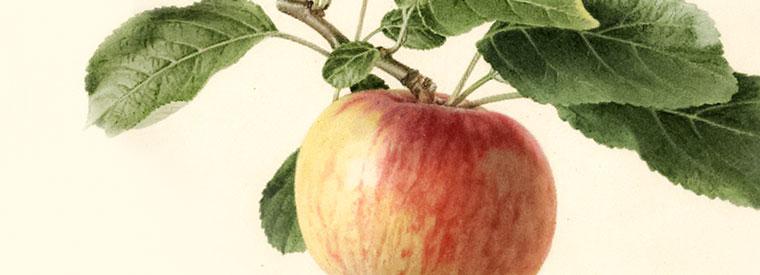Stay me with flagons; comfort me with apples.

Fruit
PILOT is also called Virginia Pilot, and documents in the USDA library files in Beltsville, Maryland, indicate that it originated on the John Lobban (or Lobbin) farm, Rockfish Township, Nelson County, Virginia, at the foot of Pilot Mountain, as a seedling about 1831. John Dollins of Albemarle County, Virginia, who sent specimens to the 1871 American Pomological Society meeting in Richmond, Virginia, propagated it. Downing in Fruits & Fruit Trees of America, 1869, notes: "…an accidental seedling found on the premises of John Robbins, at the foot of Pilot Mountain, Nelson County, Virginia." A local story from the owner of the property where the Pilot originated tells that it was brought from England and valued as a dessert apple for its great keeping quality. Large in size and round, sometimes approaching conical in shape, the yellow background is striped red and overspread with dots and specks of russet. The stalk is short and slender in a large and deep basin. The yellowish flesh is fine-grained, crisp and juicy, with a mild, subacid flavor. The core is small for a large apple. The hardy tree is round-headed and bears heavily biennially with a light crop on the off year. On size control rootstock, it seems to bear earlier and has fewer tendencies for biennial production. In upper Piedmont, the quality of the fruit on rich friable soil is very high, but the fruit at lower elevations and on poor soil is subject to many "rots" and the tree is light bearing. Pilot stores exceptionally well, and the USDA reported in 1908 that some growers would cover the fruit on the ground beneath the tree with straw, and in the spring would pack the long-keeping apples in barrels for the market. It ripens in October. Burford Brothers has reintroduced this variety to circulation.
Ripening Period
- Mid Fall - October


